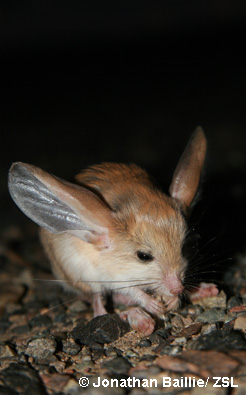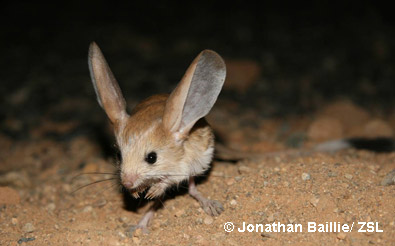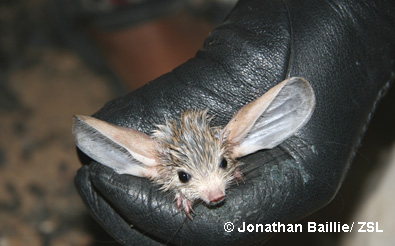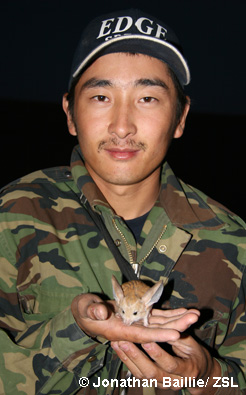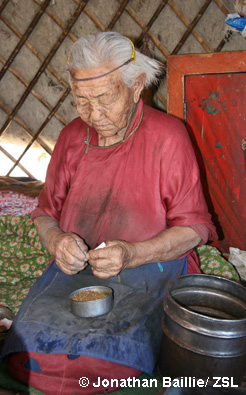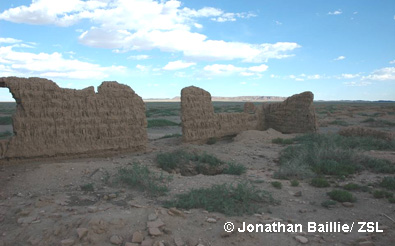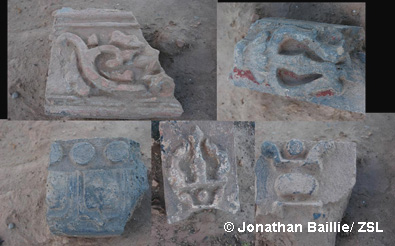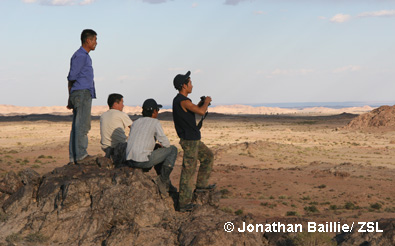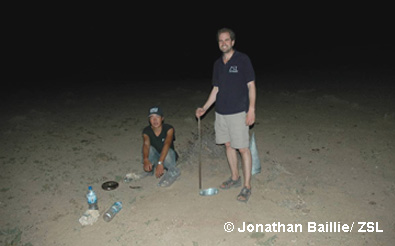We were exhausted from having been up all night, but the intense heat made it impossible to sleep. We rolled up the base of the ger to get some ventilation, but the air was completely still and heavy. When Uuganbadrakh split open a cool watermelon it was like a gift from the gods. I would not have guessed in a million years that a community of farmers living near by grew cucumbers, onions and of all things, watermelons. Using the limited water resources to irrigate desert fields for agriculture can have a major impact on the flora and fauna of the region that desperately need this water to survive. However, I did enjoy the watermelon.
It was interesting to learn that no pesticides were used, both because of the expense, but also because relatively few agricultural insect pest species survive in the desert climate. However, we also learned that the farmers view jerboas as a major problem and many have cats for the purpose of eradicating small rodents. One of the families told us that a cat could catch up to 20 jerboa’s in a night. Species such as the Siberian jerboa or the Gobi jerboa would enjoy feasting on these unusual fruits and vegetables, but the long-eared jerboa appears to eat mostly insects and it is therefore unlikely to be a major threat, but of course the cats do not discriminate. We have yet to test this, but the smaller long-eared jerboa also appears to be a bit slower then the other species and may therefore be an easier target. No long-eared jerboas were found in the immediate area around the farms.
After eating all but the skin of the watermelon we discussed next summers study design and looked through a number of the photos from the night before. When viewing the images I could not believe how lucky we had been. I wanted to watch the video footage of the long eared jerboa my sister had taken, but we needed to conserve batteries. It was exciting knowing it was the first film footage ever taken of this remarkable species in the wild.
Before leaving we went to say thank you to the herders that allowed us to stay in their extra ger. The grandmother of the house was about 92 and had only been to the capital Ulan Batar twice in her life. She was extremely charming and told us of the old days when animals were plentiful in the region, especially wild ass. She said that the major problem has been 10 years of drought and that to a lesser extent hunting and illegal mining have also had an impact. Her only son, who was about 70, said that global warming was by far the greatest future threat to people and animals in the Gobi. I wondered to myself how it was that a nomadic herder in one of the most remote parts of the little Gobi was on top of this issue when many of our world’s leaders are having a hard time grasping the concept. The potential impact of climate change is very clear in the delicate desert ecosystem where small climatic shifts often lead to extreme hardship. The son also said that illegal mining for gold was also increasing in the region and resulting in limited water resources being polluted.
As we drove south toward the Chinese border the landscape was extremely varied ranging from the classic hard baked sandy desert –
to gravel and shrubs to a rocky environment that looked like the moon.
Scanning the largely desolate horizon I was amazed see something that resembled a fortress. As we drove closer it became apparent that it was the ruins of an ancient Buddhist monastery. As I followed the foundation I was in disbelief as to the immense size of the building. There were also a large number of outbuildings. The monastery must have housed a few hundred lamas.
The EDGE Fellows explained that there were many sites like this all over the country and that during the Stalinist purges of the 1930s around 17,000 lamas were executed and most monasteries raised to the ground. Although it had happened about 70 years ago it felt as though we had come across the site shortly after the massacre. Little seems to have been touched and the beautiful symbols of the past laying where they fell.
It was hard to believe that a large community of lamas could have eked out an existence in the desolate landscape. There was likely more rain in the past and the monastery was also probably along an important trading route.
After traversing numerous rocky hills it became apparent that we were completely lost. Uuganbadrah climbed to a hill top with his assistant, Adiya and the driver and they all scanned the distant hills looking for two gers where we hoped to spend the night. It soon became clear that we had gone too far south west and had ended up just above the Chinese border.
Just before nightfall we arrived at our destination and were quickly invited into the herder’s ger for a much welcomed ceremonial drinking of Mongolian vodka followed by poetry reciting and a series of beautiful Mongolian folk songs. It was all going well until I was invited to share a few poems and songs from my county.
The following morning we woke up to a bit of a commotion as Adiya tired to remove what he called a camel spider from the ger. As he chased it down a few more started darting in and out of the walls. He told me that these were only small ones but that even these could kill a camel with one bite. I was sceptical, but it did not stop me from checking my sleeping bag.
We spent the afternoon and evening setting up the pitfall traps and Sherman traps to try and determine whether the long-eared jerboa is found in this elevated rocky landscape. The ground was much harder here and it took hours to dig the holes for the pitfall traps – no one escaped the blisters.
We then headed back to the ger to wait for the early morning hours when we would return to the field site. I thought of trying to get some sleep but could only think of the amazing desert creatures we were going to encounter.
End of part 2

